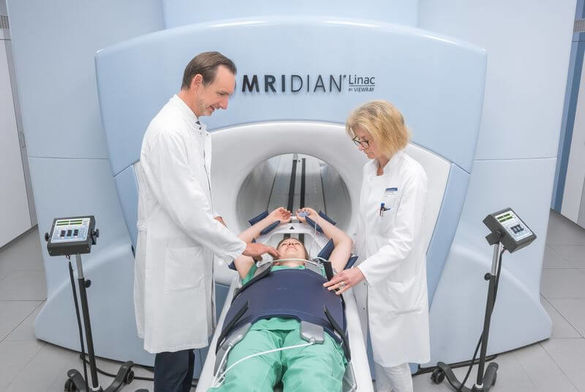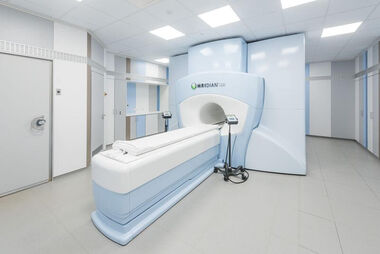Better tumor visualization: First patient in Europe treated with new hybrid radiotherapy device MR-Linac

July 2018
Two become one: For the first time in Europe, Heidelberg implemented an “MR-Linac”, a new combination radiotherapy device which enables precise tumor imaging during radiation. Using this magnetic resonance imaging (MRI) guided radiation the first treated patient’s abdominal metastases could be targeted, while sparing surrounding organs like the intestines. Thus, the Heidelberg MRgRT Consortium, a collaboration between Heidelberg University Hospital and the German Cancer Research Center (DKFZ), has achieved further success in innovative radiotherapy methods.
Hybrid Devices - two-fold benefits for patients
For radiotherapy to be successful, the position and extent of tumor must be accurately determined so that radiation can be directed precisely on the tumor. To this point, x-rays have been used to check tumor position immediately before the start of radiation. The MR-Linac device offers several major advantages:
Magnetic resonance imaging (MRI) does not cause extra radiation exposure for patients and can be safely repeated. Daily imaging data can be retrieved, so therapy can be directly adjusted on the day of treatment. The MR-Linac captures, for example, altered tumor position or significant shrinkage of the cancer during therapy. This technique reduces potential side effects of radiotherapy. MRI is also better than x-ray at distinguishing tumor from healthy tissue and offers better visualization within the tumor. Even tumors that are poorly or not at all differentiated from surrounding tissues with x-ray and have been typically identified using bony structures can now be observed with the MR-Linac throughout therapy.

Heidelberg: the world’s only center offering all high-precision radiation techniques
Prof Dr. Dr. Jürgen Debus, Medical Director of the Department of Radio-oncology and Radiotherapy at Heidelberg University Hospital and Director of the National Center for Tumor Diseases (NCT) is convinced, “Hybrid devices for MR-guided radiotherapy promise significant advancement in image-based radiation. We expect that the ability to adjust radiotherapy for mobile tumors in real-time will yield better treatment results for many patients.” The research necessary to realize the full potential of this new method with clinical implementation has already begun. Heidelberg is the only center worldwide that can offer patients the entire spectrum of high-precision radiotherapy techniques - including ion beam radiation - and this greatly simplifies comparative studies.
Further Information:
Department for Radiation Oncology

